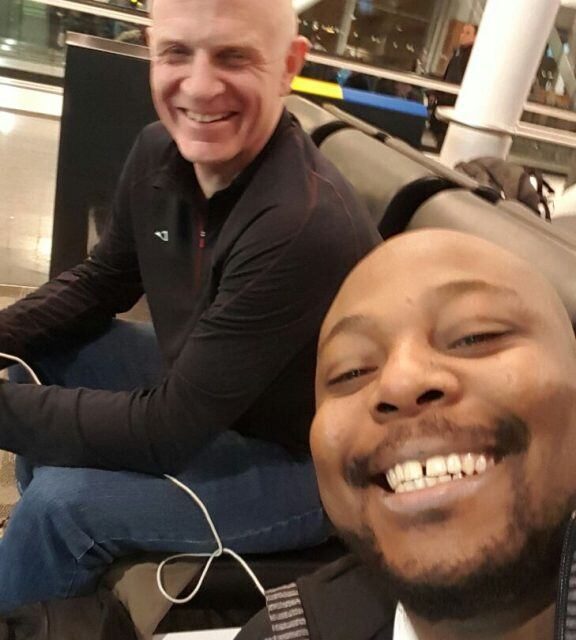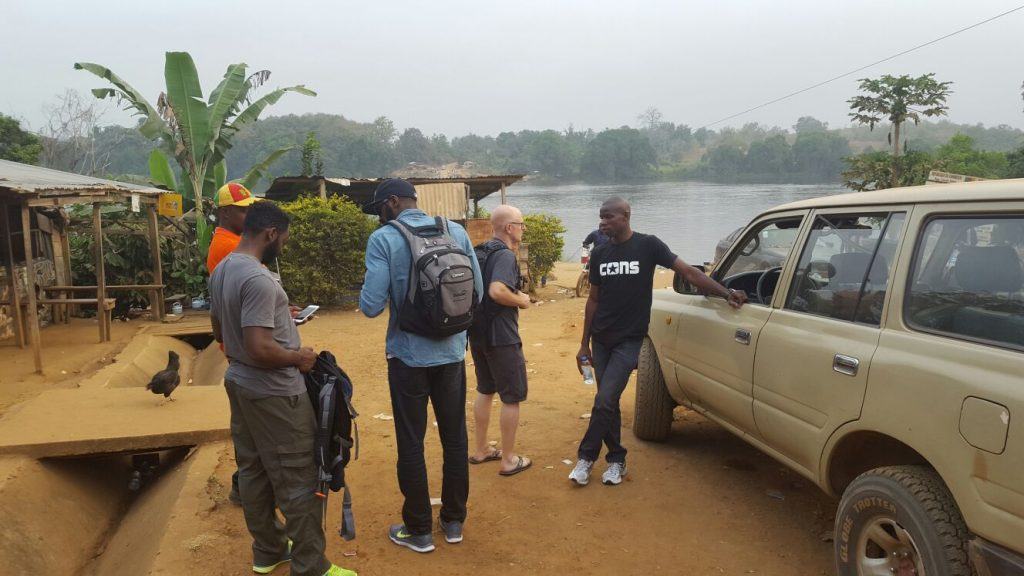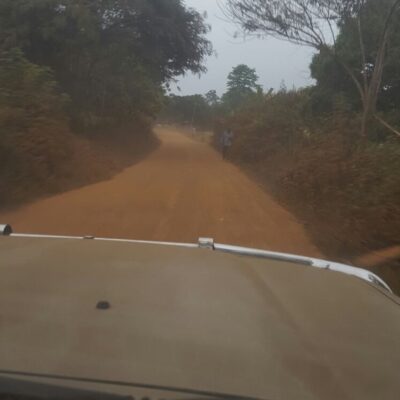Key Concepts
- Team Reunion
- Site Discovery
- Trip
- Local Realities
- Montréal – Cameroon
- Encampment
During my first visit in April 2016 which is reported in the Mbankomo article, we came to the conclusion that it would be crucial for all the participants involved with our smart village project to converge to the implementation site for the first phase. To achieve this plan the Montréal team did travel to Cameroon and on December 29, 2016, the squad was complete with First-time visitor Martin Decelles, Joseph Atangana, Romeo Ngaba and Franck Nlemba.
According to our itinerary, everybody had to converge to the implementation site located after Ntui, 180 km away from Yaoundé. It normally takes 2 hours to cover that distance, but we finally arrived at our destination about 5 hours later due to the state of the road. After a meeting with almost all permanent members of the team on the eve of the trip, a travel plan was available for everyone. This plan required each member to be up at 5 AM in order to leave Yaoundé latest by 6 AM to hopefully avoid the traffic jam at the exit point of the town.
Our Teams Gets Introduce To The “Karibu” Bush Car
The funny thing for us coming from Canada, upon arrival, was the name of the car made available for our out-of-town trips by a friendly family: It was a robust Land cruiser often used by military forces or Non-Governmental Organisation, (NGO), based in rural areas. This family had christened it “Karibu” due to its sturdiness.
At 5:55 AM, all the travelers leaving Yaoundé had already boarded the “Karibu” and we were going to pick up the last person on our way. The car had 9 available seats, and we were already 8 on-board :
- Martin Decelles, our Canadian Consultant who would go through a thrilling lifetime experience on his way back from this trip.
- Éric Nkamdem, our Administrative Officer, and Local Resource Person.
- Joseph Atangana, our Field Operations Planning Officer who had not visited Cameroon for over a decade.
- Ayissi, our local escort who was waiting for his new transfer location after working in Mbankomo.
- Charly, our All-Terrain Driver with whom we would spend the rest of the adventure in the course of our trip.
- Jean Marie, our Resource Person, and Guide who masters the village where we were heading to.
- Franck Nlemba, our Project Coordinator
- Romeo Ngaba, our Director of Operations
We left Yaoundé at 6 AM, the atmosphere and road circulation were quite appealing. No hitches experienced while driving as we were able to avoid traffic jams by hitting the road early.
We arrived at Obala at 6:15 AM and picked up the ninth passenger, Narcisse Nemi, our Farm Technician: the squad was now complete.
6:35 AM: We veered away from the car into a route covered with dust.
6:54 AM: We finally made it to the Nachtigal Ferry.
The latter usually departs at 7:30 AM. Arriving there ahead of time made it possible for some of us to take a break, and for others to freshen up by washing their faces.

The Nachtigal Ferry
It is the ferry used to cross the Sanaga River at the place called Nachtigal, located on the road connecting Yaoundé to Ntui, a Subdivision of the Mbam and Kim Division.
We were forced to resort to this means of transport since it is the shortest way to get to Ntui which is three hour drive from our current location. Every car pays the right of way at 1000 Franc cfa, about $2,50 but pedestrians and passengers get on free of charge .

7:45 AM: we crossed the River. And the trip lasted 14 minutes.
8:15 AM: we arrived in Ntui. On our way, we had spotted 2 hotels, a pump station, a district hospital, and schools. We were already in what passes for the down-town of the area and the dust cloud kept rising.
We had to lower our window glasses while driving since the “Karibu” has no inbuilt air condition system. The skin color of every passenger in the car was virtually looking the same, brown. Thanks to our excursion a new race was born. We did pass about 6 villages that border the main road on which we were driving. Those villages were almost empty since their respective villagers had already gone to farm. We also went pass herds of cows guided by shepherds coming all the way from Nord Cameroon.

10:35 AM: Here we are. It is a small locality of about 300 persons. The village length spans from one end of the road to the other. And like in other rural areas, the main activities are farming, hunting, and picking. In the community of this village, there were some strangers – non-natives -, who came purposely to work in various firms and plantations found in the area.
Though all that area is hardly accessible because of the state of the road, it remains a highly exotic destination for its virgin forest and very fertile soil.
As required by local customs, we first reported to the palace of the village to meet the chief and signify of our presence. After spending some few minutes with the chief and his notables, we hopped in the “Karibu” en route to the encampment our team had to occupy and which is located on a 20 minutes’ walk to our experimental site.
Pitching up Encampment Tents
Our greatest fear was not to know where to set up a camp for our team once the project had begun in this area. We were lucky to find a pretty large encampment near our project site following some negotiations with the owner, whom we called Tata Yvette. We came to the agreement that our team was going to stay there during the first year of experience.
Thirty minutes later, we set foot on the camp, after trampling on a rocky path strewn with Savannah grass. At last, we could now rest for some minutes before going to discover what our project site looks like.
The clock read 11:45 AM, in principle we had planned to finish work at 2 PM if we wanted to make it in time to cross the Sanaga River aboard the Nachtigal Ferry closing at 6 PM latest.
Watch out for updates…
Story written by Roméo Ngaba